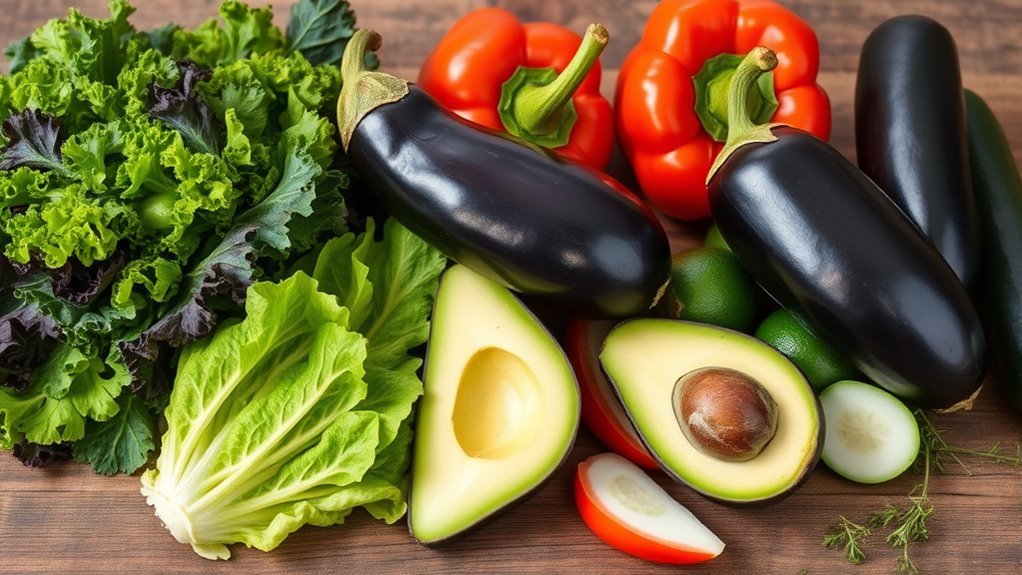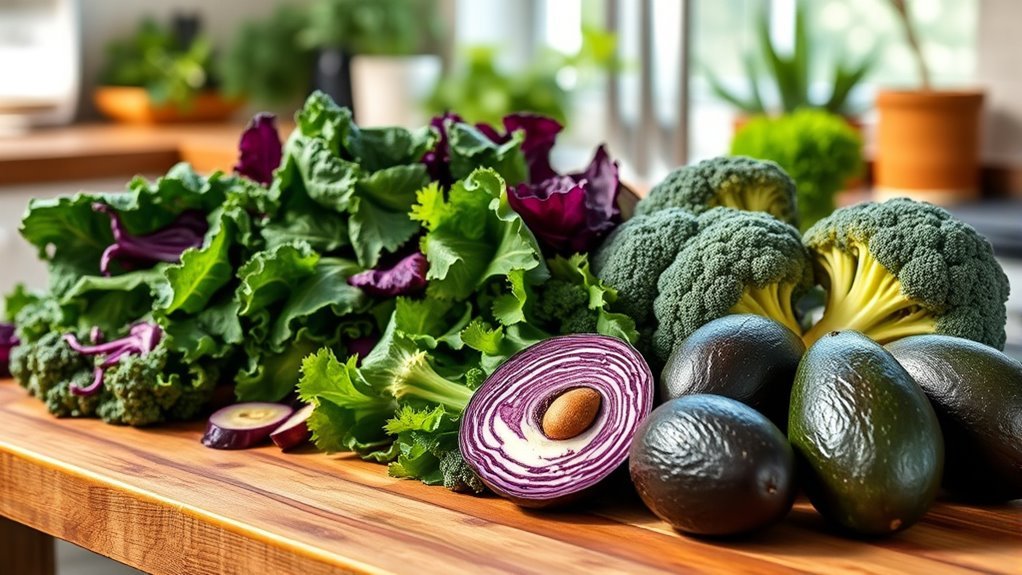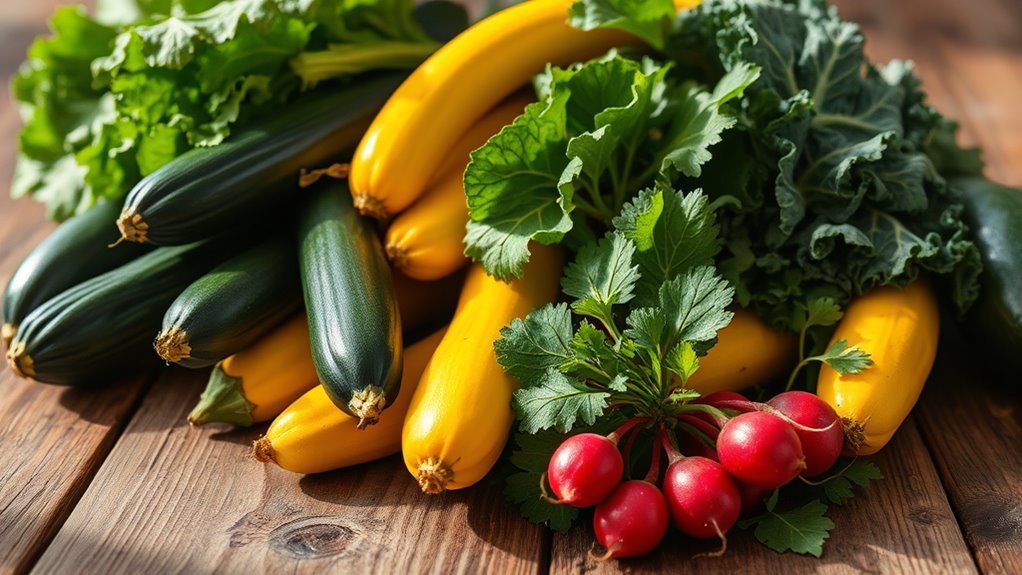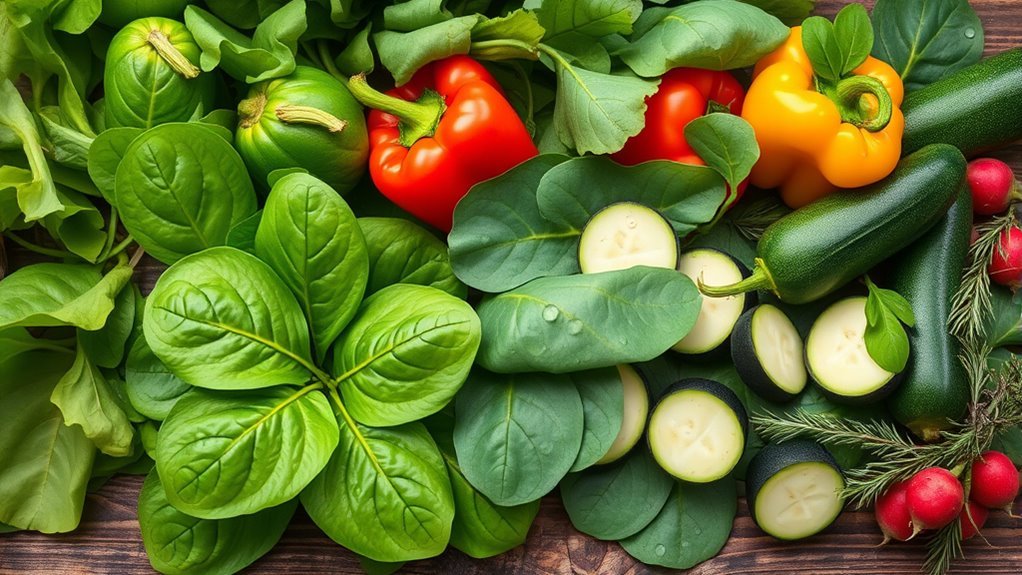On the keto diet, you can enjoy a variety of low-carb veggies like leafy greens, cruciferous vegetables, zucchini, and peppers. Leafy options such as spinach and kale are nutrient-dense and low in carbs. Cruciferous veggies like broccoli and cauliflower are high in fiber and vitamins. Zucchini provides a great pasta alternative, while peppers add flavor and vitamins. Including mushrooms, avocados, and radishes further enhances your meals while keeping carbs in check. There’s more to discover about ideal veggie choices!
Leafy Greens

When it comes to the keto diet, leafy greens are among your best allies. They’re low in carbs and high in nutrients, making them perfect for maintaining ketosis. Incorporating various leafy greens like spinach, kale, and arugula can greatly enhance your meals. Each variety offers unique leafy greens benefits, such as improved digestion and increased antioxidants. Spinach, for instance, is rich in iron, while kale provides essential vitamins A, C, and K. Eating a mix not only keeps your meals vibrant but also guarantees you’re getting a range of nutrients. Plus, their versatility means you can enjoy them in salads, smoothies, or as sautéed sides. Embrace leafy greens to nourish your body while enjoying the freedom of your keto journey.
Cruciferous Vegetables

Cruciferous vegetables, such as broccoli, cauliflower, and Brussels sprouts, are packed with nutrients that can support your health on a keto diet. They’re low in carbohydrates but high in fiber, vitamins, and antioxidants, making them excellent choices for your meal plan. Let’s explore the best options and their nutritional benefits to help you make informed decisions.
Nutritional Benefits Overview
Although many people focus on macronutrients in the keto diet, incorporating cruciferous vegetables can considerably enhance your nutritional intake. These veggies are packed with nutrient density and fiber content, making them a smart addition to your meals. They can help support digestion, promote satiety, and offer various vitamins and minerals essential for overall health.
Here’s a quick comparison of some popular cruciferous vegetables:
| Vegetable | Nutrient Density (per 100g) |
|---|---|
| Broccoli | High |
| Cauliflower | Moderate |
| Kale | Very High |
| Brussels Sprouts | High |
Best Choices for Keto
If you’re looking to maximize your vegetable intake on a keto diet, incorporating the right cruciferous options can make a significant difference. Vegetables like broccoli, cauliflower, kale, and Brussels sprouts are excellent keto friendly options. These low carb vegetables are packed with nutrients while keeping your carbohydrate count in check, making them ideal for maintaining ketosis. For instance, one cup of cooked cauliflower contains just 5 grams of carbs, while providing fiber and vitamins. Broccoli is another powerhouse, offering about 6 grams of carbs per cup, along with antioxidants. By adding these cruciferous choices to your meals, you not only enhance flavor and texture but also support your health on your keto journey. Enjoy the freedom of delicious, nutritious options!
Zucchini and Squash

Zucchini and squash are not just versatile additions to your meals; they also pack a nutritional punch. Zucchini is low in calories and high in vitamins A and C, while various cooking methods for squash can enhance its flavor and texture. Understanding these benefits can help you make informed choices in your keto diet.
Nutritional Benefits of Zucchini
While you might think of zucchini as just a low-calorie vegetable, its nutritional profile packs a punch, making it a fantastic choice for those on a keto diet. Zucchini nutrition is impressive; it’s low in carbs and high in fiber, which can help you feel full longer. This veggie is rich in vitamins A and C, antioxidants that support your immune system and skin health. Plus, it contains minerals like potassium, which helps regulate blood pressure. Whether you’re whipping up zucchini recipes like zoodles or zesty fritters, you’re adding a nutrient-dense option to your meals. Embracing zucchini not only enhances your dishes but also aligns perfectly with your keto lifestyle, providing essential nutrients without compromising your carb goals.
Cooking Methods for Squash
When it comes to cooking squash, including zucchini, there are several methods that can elevate your dishes while keeping them keto-friendly. You can sauté, roast, or grill various squash varieties to enhance their flavors. Sautéing in olive oil or butter allows you to infuse them with herbs and spices, while roasting brings out their natural sweetness. If you’re looking for a smoky flavor, grilling is a fantastic option. For a lighter dish, consider spiralizing zucchini into noodles, making a great low-carb pasta alternative. Each of these cooking techniques not only preserves the nutritional benefits of squash but also adds versatility to your meals. Enjoy experimenting and find what works best for your palate!
Peppers
Peppers are a versatile and vibrant addition to the keto diet, offering both flavor and nutrition. You’ll find various bell pepper varieties—red, yellow, and green—each packed with vitamins A and C while being low in carbs. These colorful options not only enhance your meals but also boost your immune system. If you enjoy a bit of heat, spicy peppers like jalapeños and habaneros deliver not just flavor but also health benefits, such as improved metabolism and reduced inflammation. They can add a satisfying kick to your dishes without derailing your keto goals. Incorporating peppers into your meals can keep your diet exciting and fulfilling while providing essential nutrients. Enjoy exploring the diverse world of peppers on your keto journey!
Mushrooms
Mushrooms are an excellent choice for anyone following a keto diet, as they provide a rich source of nutrients with minimal carbohydrates. With various mushroom varieties like cremini, shiitake, and portobello, you can easily incorporate them into your meals. They’re not only low in calories but also packed with vitamins and antioxidants.
Here’s a quick look at some popular mushroom varieties and their benefits:
| Mushroom Variety | Carbs per 100g | Health Benefits |
|---|---|---|
| Cremini | 3.3g | Boosts immune system |
| Shiitake | 6.8g | Supports heart health |
| Portobello | 3.9g | Rich in B vitamins |
Try experimenting with different mushroom recipes for delicious, keto-friendly dishes!
Avocado
After exploring the benefits of mushrooms, it’s time to turn our attention to another powerhouse in the keto diet: avocado. Rich in healthy fats, avocados help you stay full longer and support your weight loss goals. With various avocado varieties, like Hass and Fuerte, you can enjoy different flavors and textures. They’re incredibly versatile, making them perfect for keto-friendly recipes. You might try smashing them on low-carb bread or adding them to salads for a creamy touch. Additionally, you can blend avocados into smoothies for a nutrient boost. Their low carbohydrate content and high fiber make them an ideal choice for maintaining your ketosis while indulging in delicious meals. Embrace avocados and let your creativity shine!
Asparagus
Asparagus is a nutrient-dense vegetable that’s a fantastic addition to your keto diet. It’s low in carbs and high in fiber, making it a perfect choice for maintaining ketosis. You’ll find various asparagus varieties, such as green, white, and purple, each offering unique flavors and textures.
Here’s a quick visual guide to help you explore asparagus options:
| Asparagus Variety | Best Recipes |
|---|---|
| Green | Grilled with garlic |
| White | Creamy asparagus soup |
| Purple | Roasted with lemon zest |
| Wild | Blanched in salads |
Incorporate these delicious asparagus recipes into your meals for an easy, healthy side dish that complements your keto lifestyle while keeping your taste buds satisfied. Enjoy!
Radishes
Radishes are a crunchy, low-carb vegetable that can add a zesty kick to your keto meals. With various radish varieties available—like the classic red, daikon, and black radishes—you’ve got options to spice things up in your dishes. Radish nutrition is impressive; they’re low in calories and high in vitamins C and B6, as well as minerals like potassium and magnesium. These nutrients not only support overall health but can also enhance digestion. Plus, their peppery flavor can replace higher-carb ingredients in salads, stir-fries, or even as a dip for keto-friendly spreads. Incorporating radishes into your keto diet can help you maintain that freedom to enjoy diverse, flavorful meals while staying within your carb limits.


